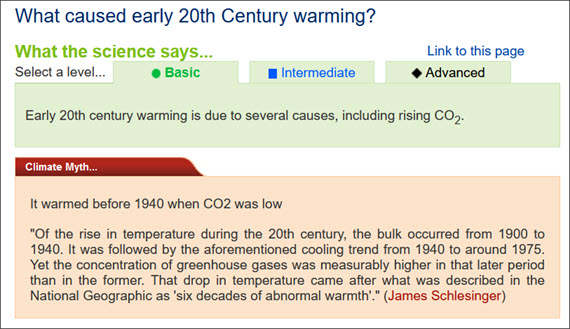At a glance - What caused early 20th Century warming?
Posted on 25 June 2024 by John Mason, BaerbelW, Ken Rice
On February 14, 2023 we announced our Rebuttal Update Project. This included an ask for feedback about the added "At a glance" section in the updated basic rebuttal versions. This weekly blog post series highlights this new section of one of the updated basic rebuttal versions and serves as a "bump" for our ask. This week features "What caused early 20th Century warming?". More will follow in the upcoming weeks. Please follow the Further Reading link at the bottom to read the full rebuttal and to join the discussion in the comment thread there.
At a glance
The Twentieth Century climate was a veritable Smorgasbord of natural and manmade factors. They vied with or against one another, driving temperatures in various directions at different times. Conditions were on the cool side up until the 1920s. That was followed by a sustained warming through to the late 1940s. From then until the late 1970s, periods of warmer and cooler conditions alternated. Thereafter, we saw the erratic but one-way climb of temperatures that has persisted through to the present day.
This was also the period during which CO2 emissions from use of fossil fuels really took off, from 1.5 billion tonnes a year in 1900, through 6 billion tonnes in 1950, 25 billion by 2000 and 44 billion now. How well do those figures correlate with what was going on in Earth's climate system at the time?
Planetary climate is affected by a number of factors. Examples include solar variability, the amount of volcanic activity, fluctuating ocean currents, cyclic variations in Earth's orbit, the strength of the Greenhouse Effect and the amount of sunlight reflected by Earth's surface. Some are forcings - factors that dictate and change the total energy within the climate system. Others are feedbacks - they respond in various ways to those changes.
Both forcings and feedbacks operate on a variable timescales - from years to millennia. That variability means they may sometimes reinforce one another and at other times cancel each other out. To assess why the climate behaved in a certain way at a certain time, all must be examined.
In the case of the 1920-1940 period, the increase in global temperature is thought to have been largely caused by three of the above factors. The amount of solar energy reaching the top of Earth's atmosphere rose steadily from 1920-1940. Although the amount of change was small, it was certainly not negligible. Volcanic activity produces atmospheric aerosols that can have a cooling effect by partly blocking out the sun. Lower than normal volcanic activity, as was the case in the 1920-1940 period, would result in less of those airborne coolants. Our early, albeit relatively low greenhouse gas emissions also contributed to the warming. Regional factors played a role in increasing temperatures in some parts of the world, too. Most notably, changes in ocean currents led to warmer-than-normal sea temperatures in the North Atlantic.
Anyone who has been around for long enough to recall the chemical smogs of the 1950s and early 1960s will know that pollution can be deadly. In one smog, in London in December 1952, between 4,000 and 12,000 people died, victims of severe respiratory disease. Governments responded. Over the next two decades numerous Clean Air Acts were passed. Pollution levels fell accordingly. But such pollutants, just like volcanic gases, are aerosols that have that same cooling effect. Clearing them away removed that effect and tore off the mask behind which CO2 emissions had been hiding - and off we went on our warming journey.
Please use this form to provide feedback about this new "At a glance" section. Read a more technical version below or dig deeper via the tabs above!
Click for Further details
In case you'd like to explore more of our recently updated rebuttals, here are the links to all of them:
If you think that projects like these rebuttal updates are a good idea, please visit our support page to contribute!































 Arguments
Arguments































Comments